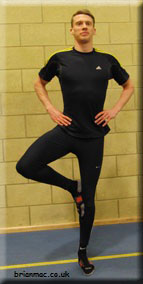

Standing Stork Test
Testing and measurement are the means of collecting information upon which subsequent performance evaluations and decisions are made. In the analysis, we need to consider factors influencing the results.
Objective
To monitor the development of the athlete's ability to maintain a state of equilibrium (balance) in a static position.
Required Resources
To conduct this test, you will require:
- Warm, dry location - gym
- Stopwatch
- Assistant
How to conduct the test
|
 |
Assessment
The following normative data is available for this test.
The following table (Johnson & Nelson 1979)[1] shows national norms for 16 to 19-year-olds.
| Excellent | Above Average | Average | Below Average | Poor | |
| Males | >50 | 41-50 | 31-40 | 20-30 | <20 |
| Females | >30 | 23-30 | 16-22 | 10-15 | <10 |
The following table (Schell & Leelarthaepin 1994)[2] shows norms for males and females.
| Excellent | Above Average | Average | Below Average | Poor | |
| Males | >50 | 37-50 | 15-36 | 5-14 | <5 |
| Females | >27 | 23-27 | 8-22 | 3-7 | <3 |
Analysis
Analysis of the test result compares it with the athlete's previous results for this test. It is expected that the analysis would indicate an improvement in the athlete's static balance with appropriate training between each test.
Target Group
This test is suitable for active individuals but not for those where the test would be contraindicated.
Reliability
Test reliability refers to how a test is consistent and stable in measuring its intended measure. Reliability will depend upon how strict the test is conducted and the individual's level of motivation to perform the test. The following link provides various factors influencing the results and test reliability.
Validity
Test validity refers to the degree to which the test measures what it claims to measure and the extent to which inferences, conclusions, and decisions based on test scores are appropriate and meaningful. This test provides a means to monitor training on the athlete's physical development.
Advantages
- No equipment required
- Simple to set up and conduct
- It can be conducted almost anywhere
Disadvantages
- Assistant required to administer the test
References
- JOHNSON, B.L. and NELSON, J.K. (1979) Practical measurements for evaluation in physical education. 4th Edit. Minneapolis: Burgess
- SCHELL, J. and LEELARTHAEPIN, B (1994) Physical Fitness Assessment in Exercise and Sports Science. 2nd Ed, Leelar Biomedisience Services, Matraville, NSW. p. 327
Page Reference
If you quote information from this page in your work, then the reference for this page is:
- MACKENZIE, B. (2000) Standing Stork Test [WWW] Available from: https://www.brianmac.co.uk/storktst.htm [Accessed